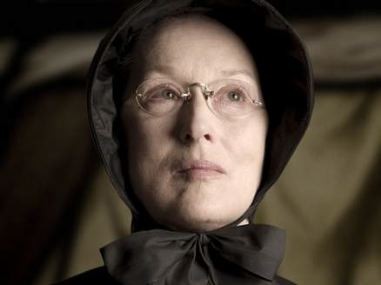Doubt

It is commonly assumed, and regularly taught, that the key difference between playwriting and screenwriting is that the former tells the bulk of its story with words (it is dialogue-driven), while the latter relies more heavily on images (it is camera-driven). This may be true, but a less obvious difference is that onstage one needs words and performance to draw the audience’s attention to a certain spot or action (“Hey, look here!”), while onscreen all you need is a close-up or a camera move—the viewer can’t look anywhere else, no matter how much they might wish they could. It is a technique that served such visually teasing directors as Hitchcock and Polanski quite well, and it is at the heart of the film adaptation of Doubt, a 2004 Pulitzer Prize–winning play by John Patrick Shanley.
Doubt is a mystery story embracing a morality play concerning the things we know and those we only suspect. The tale takes place at St. Nicholas Catholic parish in the Bronx in 1964, where the old ways are gradually changing. President Kennedy, the patron saint of Catholic schoolboys in the 1960s, has been assassinated, leading to a new national sense of vulnerability. The reforms of Vatican II have begun to trickle down to the priests and nuns. The young and energetic priest, Father Brendan Flynn (Philip Seymour Hoffman), represents the future, and the strict and stern school principal, Sister Aloysius Beauvier (Meryl Streep), personifies tradition. This is made clear during Sister Aloysius’s initial entrance, where she whacks a misbehaving kid across the back of the head to get his attention. The character in the midst of this ecclesiastical struggle, the one the viewer identifies with, is the sweet and dedicated Sister James (Amy Adams), who admires the compassion of Father Flynn while respecting the dedication of Sister Aloysius.
She is also the character who opens up the story’s Pandora’s box, turning a growing hostility between Sister Aloysius and the priest into an all-out war. She is concerned about the amount of personal attention that Father Flynn is paying to Donald Muller (Joseph Foster II), who is the school’s first and only black student. It could just be that Father Flynn is reaching out to help a young boy in need, which is what she wants to believe, or it could be that Father Flynn is engaged in an unhealthy relationship with the boy, which is what she fears. When she takes those fears to Sister Aloysius, who has her own concerns about the forward-thinking priest, hell breaks loose—a bit at a time.
The question at the film’s core is whether Sister Aloysius’s judgment is colored by her disdain for Father Flynn, not to mention her long-simmering resentment at the subservient role the nuns must play in the church, even though they are the ones who keep things going on a daily basis, making the tough decisions about right, wrong and the gray areas in between.
The movie has two significant strengths, starting with the mesmerizing performances. Streep is hypnotic as a woman who must trust her instincts, despite knowing that she is dealing with a man’s life and career, while Hoffman is nearly as good as a man who is trying desperately to navigate the choppy waters between two dangerous worlds. The film’s most remarkable performance, however, is by Viola Davis as Mrs. Muller, Donald’s mother. She has only one scene, in which Sister Aloysius reveals the fears about her son, but the way Davis deals with the news, showing in her face and bitter delivery that this is just another in a long line of indignities her people have suffered over the centuries, is the stuff that Academy Awards are made of.
Also impressive is the script itself, which Shanley has expanded a bit from the stage production. Of special note are the parable-like sermons that Father Flynn preaches to his lower-middle-class congregation and the electric confrontations between the priest and the nun in which nagging thoughts turn into direct accusations.
Where the film loses its footing is in the direction. Shanley chose to direct it himself, his first film directing assignment since 1990’s Joe Versus the Volcano, and the 18-year layoff shows. The direction is heavy-handed, lacking the subtlety that the film demands. It’s bad enough that he keeps having leaves blow around and windows rattle to remind us that the “winds of change” are blowing, but instead of relying on faces and gestures to suggest the way that confused people respond to confusing information, Shanley cuts away to a meaningless image or allows his camera to sort of drift. How much stronger the film would have been in the hands of someone whose visual sense was acute enough to make shot choices that would capture the underlying tragedy.



